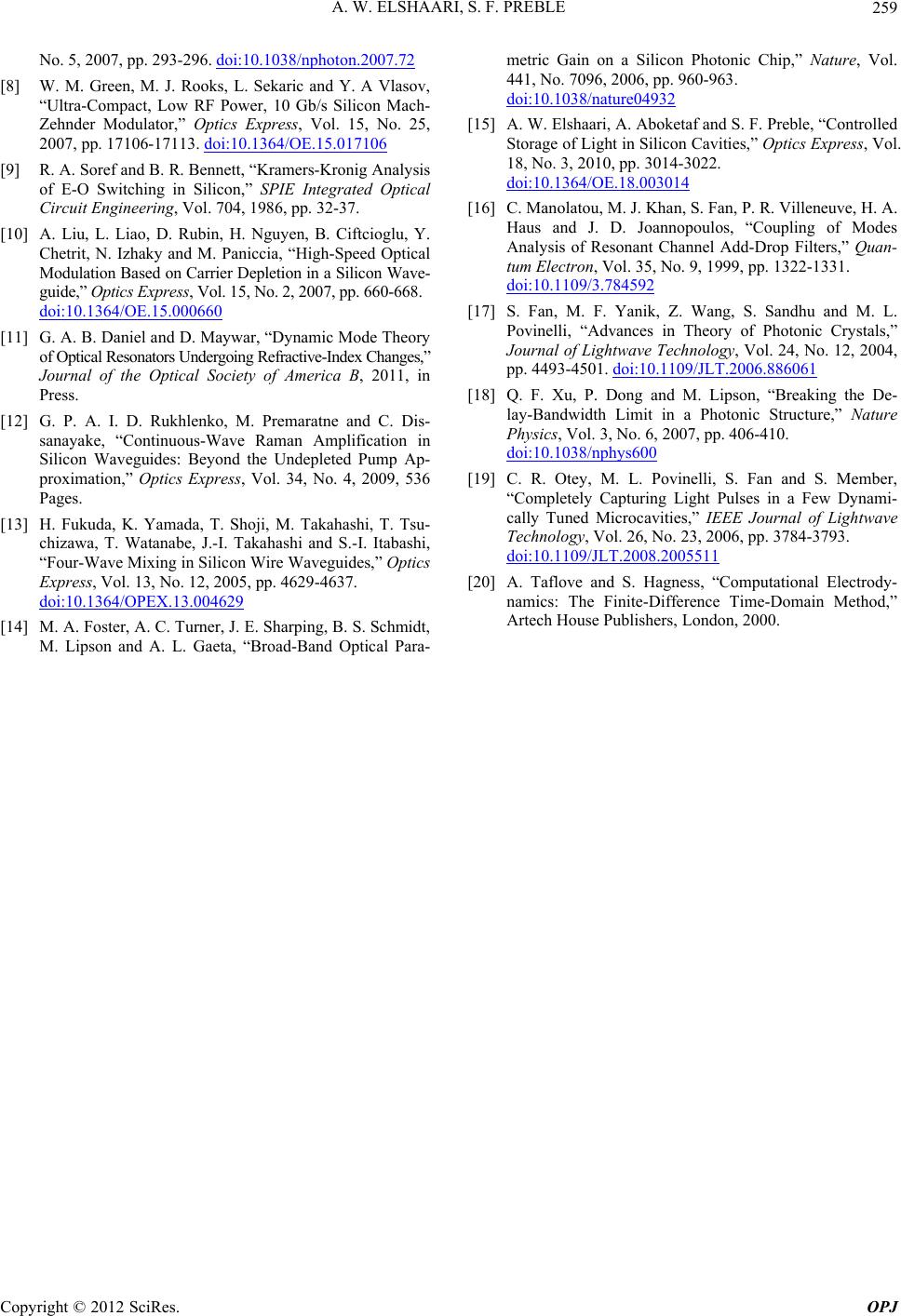
A. W. ELSHAARI, S. F. PREBLE
Copyright © 2012 SciRes. OPJ
259
No. 5, 2007, pp. 293-296. doi:10.1038/nphoton.2007.72
[8] W. M. Green, M. J. Rooks, L. Sekaric and Y. A Vlasov,
“Ultra-Compact, Low RF Power, 10 Gb/s Silicon Mach-
Zehnder Modulator,” Optics Express, Vol. 15, No. 25,
2007, pp. 17106-17113. doi:10.1364/OE.15.017106
[9] R. A. Soref and B. R. Bennett, “Kramers-Kronig Analysis
of E-O Switching in Silicon,” SPIE Integrated Optical
Circuit Engineering, Vol. 704, 1986, pp. 32-37.
[10] A. Liu, L. Liao, D. Rubin, H. Nguyen, B. Ciftcioglu, Y.
Chetrit, N. Izhaky and M. Paniccia, “High-Speed Optical
Modulation Based on Carrier Depletion in a Silicon Wave-
guide,” Optics Express, Vol. 15, No. 2, 2007, pp. 660-668.
doi:10.1364/OE.15.000660
[11] G. A. B. Daniel and D. Maywar, “Dynamic Mode Theory
of Optical Resonators Undergoing Refractive-Index Changes,”
Journal of the Optical Society of America B, 2011, in
Press.
[12] G. P. A. I. D. Rukhlenko, M. Premaratne and C. Dis-
sanayake, “Continuous-Wave Raman Amplification in
Silicon Waveguides: Beyond the Undepleted Pump Ap-
proximation,” Optics Express, Vol. 34, No. 4, 2009, 536
Pages.
[13] H. Fukuda, K. Yamada, T. Shoji, M. Takahashi, T. Tsu-
chizawa, T. Watanabe, J.-I. Takahashi and S.-I. Itabashi,
“Four-Wave Mixing in Silicon Wire Waveguides,” Optics
Express, Vol. 13, No. 12, 2005, pp. 4629-4637.
doi:10.1364/OPEX.13.004629
[14] M. A. Foster, A. C. Turner, J. E. Sharping, B. S. Schmidt,
M. Lipson and A. L. Gaeta, “Broad-Band Optical Para-
metric Gain on a Silicon Photonic Chip,” Nature, Vol.
441, No. 7096, 2006, pp. 960-963.
doi:10.1038/nature04932
[15] A. W. Elshaari, A. Aboketaf and S. F. Preble, “Controlled
Storage of Light in Silicon Cavities,” Optics Express, Vol.
18, No. 3, 2010, pp. 3014-3022.
doi:10.1364/OE.18.003014
[16] C. Manolatou, M. J. Khan, S. Fan, P. R. Villeneuve, H. A.
Haus and J. D. Joannopoulos, “Coupling of Modes
Analysis of Resonant Channel Add-Drop Filters,” Quan-
tum Electron, Vol. 35, No. 9, 1999, pp. 1322-1331.
doi:10.1109/3.784592
[17] S. Fan, M. F. Yanik, Z. Wang, S. Sandhu and M. L.
Povinelli, “Advances in Theory of Photonic Crystals,”
Journal of Lightwave Technology, Vol. 24, No. 12, 2004,
pp. 4493-4501. doi:10.1109/JLT.2006.886061
[18] Q. F. Xu, P. Dong and M. Lipson, “Breaking the De-
lay-Bandwidth Limit in a Photonic Structure,” Nature
Physics, Vol. 3, No. 6, 2007, pp. 406-410.
doi:10.1038/nphys600
[19] C. R. Otey, M. L. Povinelli, S. Fan and S. Member,
“Completely Capturing Light Pulses in a Few Dynami-
cally Tuned Microcavities,” IEEE Journal of Lightwave
Technology, Vol. 26, No. 23, 2006, pp. 3784-3793.
doi:10.1109/JLT.2008.2005511
[20] A. Taflove and S. Hagness, “Computational Electrody-
namics: The Finite-Difference Time-Domain Method,”
Artech House Publishers, London, 2000.